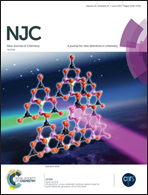High performance anti-corrosive epoxy–titania hybrid nanocomposite coatings†
Abstract
Mechanical stability, surface hydrophobicity, and thermal stability of anticorrosive polymeric coatings play a significant role in technological and industrial fields. In view of this, the present study demonstrates the design of transparent organic–inorganic hybrid nanocomposite coatings with improved mechanical strength and barrier properties. Herein, a suspension was formulated containing in situ grown titania (–O–Ti–O–) from titanium isopropoxide (TIP), diglycidyl ethers of bisphenol-A (DGEBA), and polyamide (PA). TIP simultaneously acts as a condensation agent, bridging agent (–O–Ti–O), as well as an inorganic surface modifier to epoxy resin and increases the water contact angle due to topographical improvement via optimum cross-linked surface density. The surface, morphological, thermal, and electrochemical techniques highlight broader application areas for these hybrid polymeric materials. The lowest Icorr value of 2.5211 × 10−10 for DGE–TiO2–PA hybrid coatings compared to those of DGE–PA (2.1029 × 10−7), CS (8.9131 × 10−5), and other reported coating systems in saline (3.5 and 5 weight% NaCl) environments projects DGE–TiO2–PA as a potential anticorrosive coating material.



 Please wait while we load your content...
Please wait while we load your content...